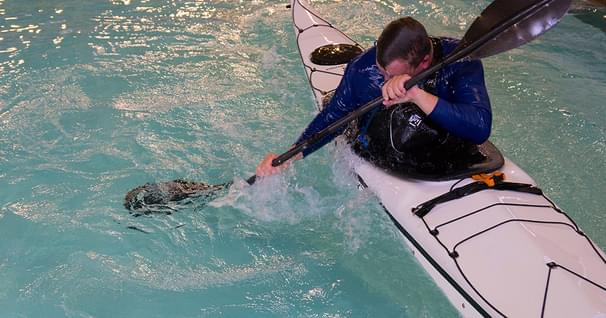Proper Technique for Paddling a Kayak
Kayak outfitting has become more and more comfortable. So comfortable in fact, that it often promotes lounging instead of good paddling posture. Of course, there's nothing wrong with lounging in your kayak, but we're going to take a quick look at the ideal sitting position when you're paddling your kayak. Because good posture will let you paddle harder, longer, and you'll avoid issues like back pain.
The ideal sitting position is upright, just like Mom always told you to do at the dinner table. Your feet should be resting comfortably and securely against the foot pedals or in the foot wells, and your legs should be comfortable flexed and somewhat splayed out. This leg position makes sitting upright easier, and reduces the strain on your hamstrings and back.
Most kayaks also now come with some type of back support. Of course they're great for lounging, but when they're tightened they also encourage an upright sitting position. One of the most common reasons for people being uncomfortable while kayaking, is because of tight hamstrings. It makes sitting upright with the legs in front very tricky. If you're having that problem, it's worth taking the time to do some stretching.
We've already discussed how to choose a paddle, so now we're going to take a look at how you'll use it.
To start off, if you're using a feathered paddle, you need to decide which is your control hand. In general, right-handed people will use the right hand as a control hand, and left-handed people will use their left hand as a control hand. This is also referred to as the "glue" hand.
The control hand's grip should never change, regardless of what type of stroke you're taking. Your control hand should grip your paddle anywhere from four to eight inches from the blade, and your knuckles should be aligned with the edge of your paddle blade. Your other hand should be holding the paddle an equal distance from the blade.
A good way to quickly check to see if your hands are in a good position is to life your paddle up onto your head. Your elbows should be bending 90 degrees. This hand placement gives you the best mix of control and power.
After taking a stroke with the blade by your control hand, you'll loosen your other hand, which we call the "grease" hand, so the shaft can rotate within it before you take the next stroke. This rotation is necessary to accommodate the feather or twist of your paddle, and will let you place the next blade in the water squarely.
This loosening of the grease hand in the rotation of the shaft within it takes place between each stroke. If you're using a paddle with no feather or twist, you won't need to worry about rotating the shaft between strokes. Most people find this more natural.
Although I learned to kayak with a feathered paddle, I now use a paddle with no twist for all the paddling that I do. I find it easier to use and better for my wrists. Something else to keep in mind, is that it's important that your grip on the paddle be secure, but light. A light grip will let you paddle more comfortably for longer, and will help you avoid overuse injuries, such as tendinitis in the wrist.
Related Articles
By changing how you edge and balance your boat you can increase your stability and adaptability. Using…
Whether you were new to paddling in 2018 or you're an experienced paddler, you can never stop learning.…
Mention “pool session” and the first image that pops into most kayakers minds is a class in how to roll.…
Photo Credit: Darlene Patterson Many people who have paddled for years can't keep a canoe on a straight…



